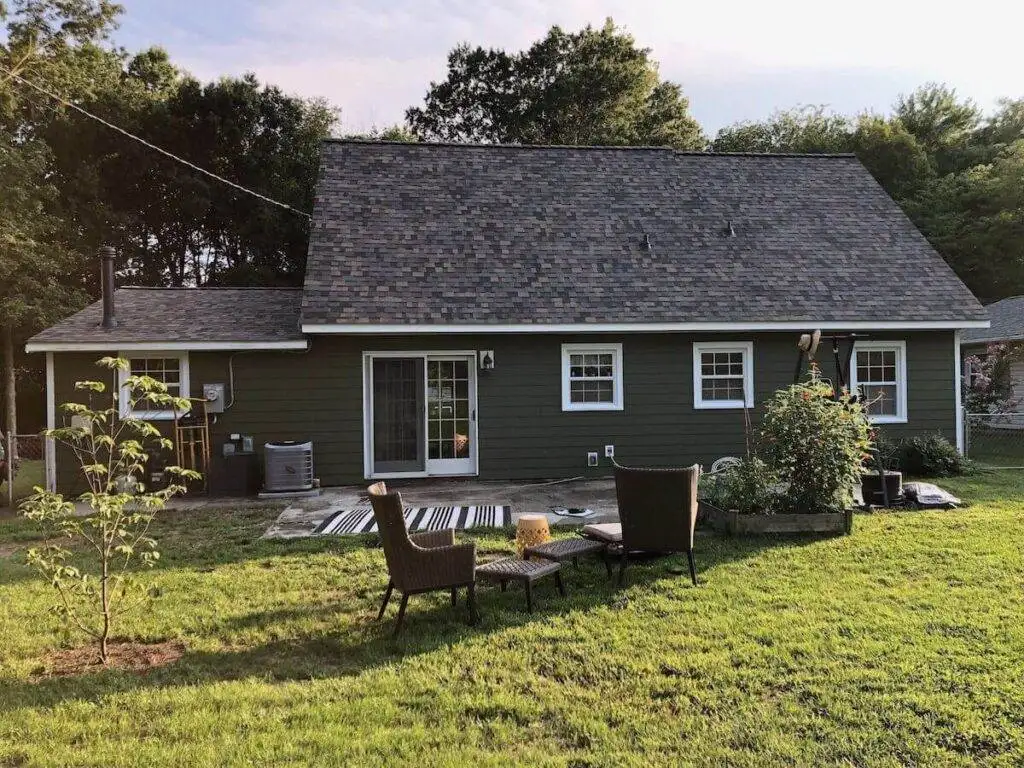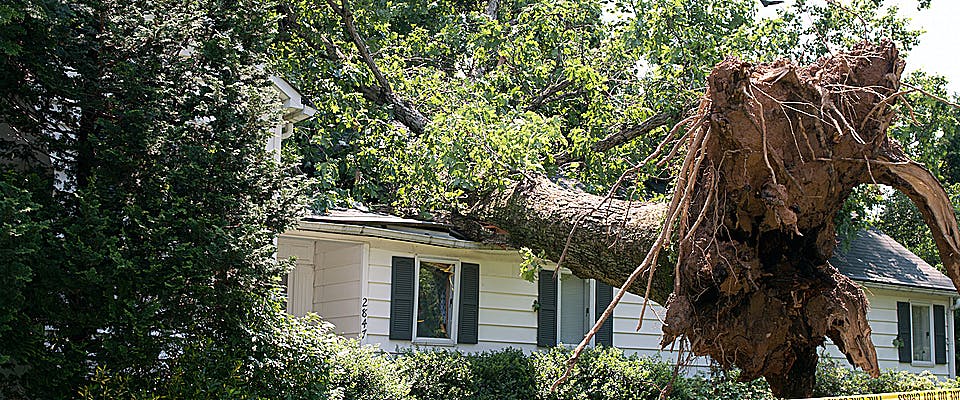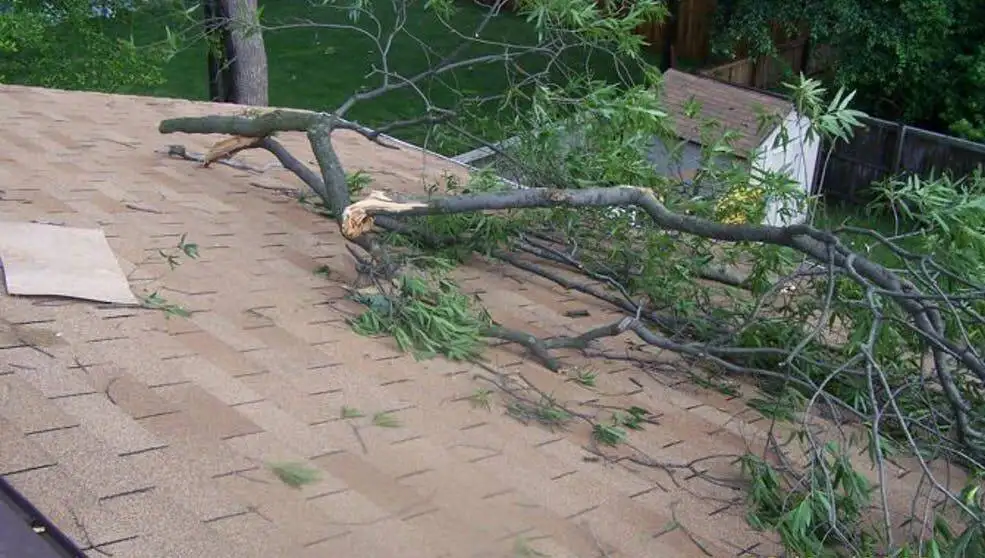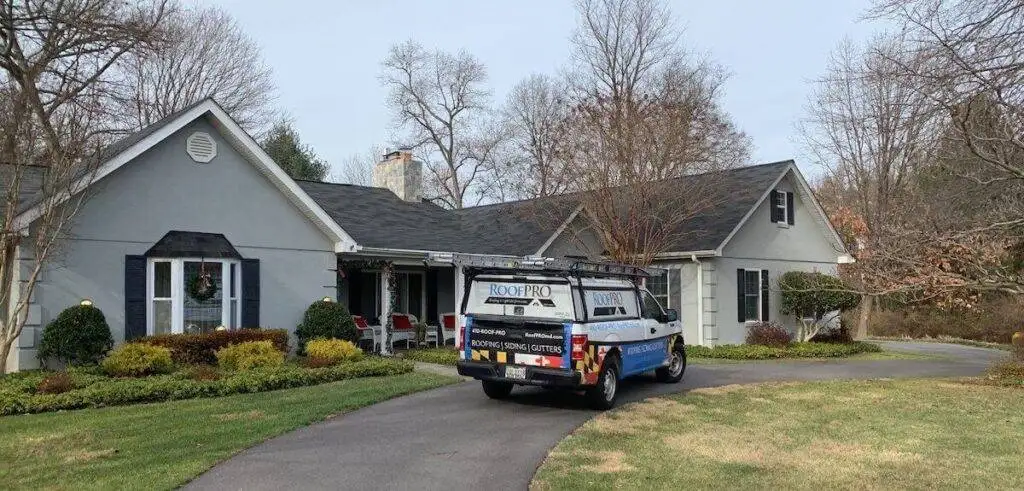Whether a tree falls from storm damage, old age, or after rotting through, the damage it can cause to your roof if it lands on your home can be catastrophic. If your roof is impacted by a tree (or even a large fallen branch), there are several critical steps you’ll need to take both in the short-term and long-term to prevent further structural damage and ensure your family’s safety. In this guide, we’ll cover the most important things you need to do if a tree falls on your roof! Feel free to contact our team at RoofPRO today for more information.

A Fallen Tree Can Be a Major Disaster for Your Home
Fallen trees are one of the most common causes of roof damage in the United States and one of the most critical types of damage to address as soon as possible. Fallen trees of any kind can cause significant damage, from a large branch that breaks off of a tree and lands on your roof to entire large trees that collapse! Whether a fallen branch makes a hole in your roof or a collapsed mature tree takes out an entire section of it, you can take a few immediate steps to ensure your family’s safety and start the restoration process.
Steps to Take in the Event of a Tree Fall on Your Roof
If a tree or a broken branch falls on your roof, there are several steps you should take right away. It’s important to note that each situation can have different hazards, from high winds or other severe weather to downed power lines and more.
Carefully assess the situation before taking action, and always err on the side of caution. Remember: in an emergency situation, safety for you and your family is the priority!
1) Evacuate Your Home
If a large enough tree or branch falls on your roof, your home’s structural integrity could be compromised. If there is any doubt about whether it’s safe to be in your home, take immediate action and evacuate your family to a safe place, such as an outbuilding, a neighbor’s home, or a vehicle.
It’s important to note that, in some cases, evacuation might not be immediately possible – severe weather, downed power lines, and other hazards might make evacuating more hazardous than staying put at a given time. If that is the case, relocate to the most visibly stable part of your home and keep an eye out for other hazards, such as glass from broken windows or debris from the impact.
2) Call 911 for Immediate Assistance
If the damage is severe, anyone is injured, or hazards like downed power lines or ruptured gas pipes are present, contact emergency services right away. Even if the damage to your house is minimal and no one is hurt, it’s vital to contact EMS if these hazards are present so the fire department can assess the danger and, if needed, enlist your local utility company to shut off the gas or de-energize damaged power lines.

3) Assess the Damage and Contact Your Insurance Company
Once the immediate danger has passed and any hazards have been dealt with by your local fire crew, the restoration process can begin. Safely examine the extent of the tree damage to your home, but use caution – never attempt to climb onto a damaged roof to get a better view of the damage.
After your initial assessment, it’s time for your homeowner’s insurance to do the heavy lifting. Contact your insurance company and start filing an insurance claim. From there, an adjuster should visit your home to process your case, inventory the damage, identify the cause (such as whether the damage came from your neighbor’s tree or your own), and apply any benefits or coverage from your home insurance policy to the cost of needed repairs.
4) Get the Tree Removed
Before the roof repair can begin, the tree that caused the damage must be removed from either your property or your neighbor’s property – whether that means cutting up and removing an entire tree that has fallen into your home or cleaning up the debris from large branches. In most cases, tree removal for fallen trees will also include any remaining section of the damaged tree that didn’t fall, such as stumps or leftover trunk sections that didn’t fall.
5) Contact a Professional Roofer for Repairs or Replacement
Finally, one of the most critical steps you can take after a tree falls on your roof is to contact and schedule comprehensive roof repair as soon as possible to prevent water damage and other complications from developing.
Before you consult a roofing contractor for repairs, it’s a good idea to contact your insurance agent and ask if they have a preferred vendor for roofing services. Your agent can also help you clarify what kinds of repairs your homeowner’s insurance coverage will pay for, and can answer any other questions about your insurance policy you may have before the restoration process begins.

5) Inspect for Smaller Damages
If smaller branches fall on your roof, there is still a chance that there could be damage that you can’t see from the ground. Branches can puncture shingles or crack slate in subtle ways that will develop into a larger problem down the road. That’s why it’s important to have the roof thoroughly inspected after the cleanup to ensure that no other areas were punctured.
RoofPRO is a Trusted Roofer for Maryland Homeowners
If you’re looking for a top-rated roofing contractor that can assist with getting your home back in top shape after a disaster, look no further than our team at RoofPRO. For more than 20 years, RoofPRO has been providing industry-leading roofing services throughout Maryland, and our dedication to quality workmanship, outstanding customer service, and proven results have earned us our reputation as a top roofing company in the region!
Top-Rated Storm Damage Roofing Solutions
RoofPRO is your local expert for storm damage roofing repair. From roof damage caused by high winds and severe weather to damage from fallen tree branches and more, our team of industry experts is ready to get your roof repaired as quickly as possible after the worst happens.
Roof Replacement and Emergency Response Services
At RoofPRO, we understand how urgent roofing repair is after severe weather blows through. Our comprehensive roof repair and roof replacement services include emergency response solutions for when the worst comes to pass. Once the danger has passed, we’ll be there to help you get back to normal as soon as possible.
We Can Work with Nearly Any Roof Material on the Market
Our top-rated team of industry experts are trained and experienced in installing, repairing, and replacing nearly every type of roofing material, from basic asphalt shingles to concrete tiles, metal roofing, solar panels, and more!

Emergency Roof Tarping and Temporary Repairs
After a tree falls on your roof, preventing further water intrusion should be your top priority. Even if major repairs can’t begin right away, temporary protection can make a big difference. Our emergency roof repair and tarping services offer immediate relief for Maryland homeowners facing sudden damage from fallen trees, wind, or hail. A professional emergency tarp acts as a watertight barrier to stop leaks and safeguard your home until full repairs can take place.
If you’d like to learn more about how roof tarps work or what materials are used, check out our detailed guide on emergency tarp roof solutions. Understanding the basics of temporary protection helps homeowners stay one step ahead during stressful situations — and ensures you know what to expect when RoofPRO arrives to help secure your home.
Hail or Wind Involved? Look for Hidden Damage Too
Fallen trees often arrive hand-in-hand with severe weather. If hail or high winds were part of the storm, there may be subtle shingle bruising, granule loss, flashing displacement, or loosened ridge vents that you can’t see from the ground. To understand what size stones are likely to bruise or fracture your roofing system, see What Size Hail Will Damage a Roof? If gusts tore at your shingles or drip edge, our wind & hail roof damage resource explains what to look for and why quick repairs matter. When the weather leaves a mixed bag of issues, our storm damage repair services team can inspect the whole system—not just the tree impact zone.
When Repair Isn’t Enough: Coordinating a Roof Replacement
Sometimes a fallen tree compromises so much structure that replacement is the smarter, safer route. We’ll help you compare scopes and timelines, coordinate with your adjuster, and keep the home dry during the transition with emergency tarping. If severe weather (hail + wind) drove the claim, keep this wind & hail roof damage resource handy for coverage conversations, and lean on our storm damage repair services to ensure code upgrades, ventilation, and flashing details are handled correctly the first time.
Proud to be a Local Roofer in MD Since 2004
For two decades, RoofPRO has been a go-to local roofing contractor for homeowners throughout Maryland. Our years of experience living and working in Maryland have taught us exactly what our roofs have to be ready for. We’re here to help through every step of the repair process, from the initial estimate to the final signature on a job well done.
Contact Us Today for a Free Inspection and Estimate
To learn more about our top-rated roofing services, contact us today for a free inspection and estimate!


Author Bio
Tim Taylor – Owner & Founder of RoofPRO
Tim Taylor began his roofing career in 2003 and founded RoofPRO in 2004 with a mission to fix the poor workmanship that often causes roof leaks. With over 20 years of hands-on experience, he’s earned elite credentials like CertainTeed’s ShingleMaster Wizard certification, HAAG inspection certifications, and OSHA safety training. His expertise in leak repair, flashing repair, and post-storm restoration has made RoofPRO one of Maryland’s most trusted roofing companies. Tim continues to lead with the same principle that built his reputation—roof it right the first time

